Soldiers of the Tercio used to have a variety of weapons depending of their speciality. Basically we have:
3.1 The Pikeman 3.2 The Harquebusier and musketeer
3.3 Flags and Uniforms
3.1 The PikemanThe Pikeman was the heart of the Tercio, especially in the XVI century, he had a long pike as offensive weapon and a full armour or corselet to protect himself.
The pike
Main weapon of the pikeman, the pike used to have a dimension of 5 to 6 meter. In his book De la Cuesta talks of a pike of 5.2 m for the Spanish Tercio and Quatrefage of a pike of 5.46 m (26 palmas de manos). Against cavalry the pike was put one side down with an angle of 45º. Against infantry the pikeman would level the pike and close to the enemy, it is the "push of the pike".

In the Push of the Pike, only the first 4 or 5 rows acted against the enemies, the others gave the push and maintain the momentum of the assault. Also they would filled the gaps in the front rows. It is common sense to imagine that a push of the pike fight was a bloody affair for the front rows. The halberd
It is a small pike of two meter with an iron point on the top and with a blade on the side. This weapon is easier to handle than the pike of 5.2 m, especially aboard a ship or in a fortress. As hierarchy symbol, the captain has a "lanza jineta", the sergeant a halberd and the capos of the pike companies a "partesana".Full armour and Protection
To protect himself the pikeman used to have a heavy full armour (some 15 kg) usually comprising back and breastplates, gorget, tasset for the thighs and arms plates. Pikeman used to have a helmet the famous "Morrion" and sometimes a shield the "Rodela". Not all the pikmen had a full armour and some of them had only part of this protection others had no armour at all and were called picas secas.(dried-pike).

Pikeman of the first half of the XVII century, called "pica seca" with just a gorget and a helmet, a spanish "morion" or capacete. As weapons, he had a pike, a sword and wear a red slash.
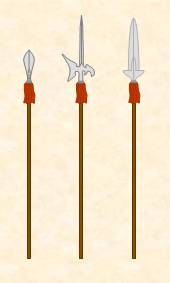
The figure give a short presentation of three hierarchy symbols a "lanza jineta", a halberd and a "partesana"
The sword
The infantry sword was a self defense weapon for the pikemen and the gunmen and most of them, were made in Toledo. One of the tipical spanish sword was a cup hilt sword, 95 cm long (4.5 palma de mano) called "espada cazoleta", used for cutting and thrusting. This sword was used with a secondary weapon like a dagger. For a spanish soldier, the sword was an important tool usefull in skirmishing action or to defend his honour.

Sword of the "Cazoleta" type and a dagger attached to a belt for the equipement of a pikeman.
3.2 The Harquebusier and musketeerThe gunmen were an innovation in the Tercio and had a terrific impact on the battlefield, even if their main weapon was archaic and unreliable in comparison with ours.
The harquebusier had a harquebus as offensive weapon and a sword. To protect himself he generally had a helmet and a buff coat. The rest of his equipment was a bandolier with 12 ready made doses of black powder, a bag full of bullets and matches, a flask containing a reserve of 0.58 kg of black powder and a small flask with thin black powder.
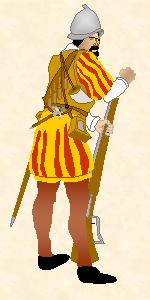
The musketeer had the same equipment than the harquebusier but instead of a harquebus his main weapon was a heavy musket and he used a fork of 1.47 m to support it.

The Harquebus: The harquebus was a handgun which weight was around 5 to 7 kg for a dimension of 0.9 - 1 meter. To ignite the powder and shot, the main method was the matchlock system. This weapon had a maximum range of 100 meter but the effective range was closer to 15 - 25 m. A study made in Austria in 19888 had shown that after 30 m the weapon was useless. Another limitation of the weapon was the rate of fire, normally a good gunman would fire 3 bullets/min. Also due to poor metal casting the tube had the tendency to overheat after 4 shots. By the end of the XVI century an advanced and longuer ( up to 1,3 meter) harquebus was introduced, called caliver with a standarized bore size, in the dutch and spanish armies.
Note: From 1685 the harquebus is still in use in the Tercio but it will be more normal to call them light musket.
Matchlock harquebus of XVI century

Matchlock Caliver of the begin of the XVII century

The musket : The musket is bigger and heavier than the harquebus. Typically a musket of the XVI century had a lenght of 1.4 - 1.5 m and a weight of around 10 kg. To fire, a musketeer had to use a rest called the forks. The firing rate was slow, 1 shot/min and 44 mouvements were needed to load the weapon. The main advantage of the weapon was the effective range of 50 to 75 meter and a maximum range of 300 meter. Also, the heavier bullets of the musket could penetrate the full armour of the heavy horsemen. In 1610 a mousquet in Spanish service, had a lenght of 1.3 - 1.4 m and a weight of 8 - 9 kg firing a bullet of 42.5 g, with an initial speed of some 300 m/s.During the XVII century the muskets have been lightened (6 - 6.5 kg for a a lenght of 1.2 m), improving the casting techniques and by the second half of the XVII century muskets without the forks were common. Also the techniques to ignite the powder were improved with the wheellock system (in swedish service) to arrive to the flintlock system by the end of the century.
Matchlock musket of the XVII century

The Flint musket or Fusil: The flintlock musket was a synthesis of the advances of the XVII century. Its characteristics were length of 1.4 - 1.5 meter and a weight of 6 kg. The main advantage of the musket was the weight and the simplicity to load the weapon as it required only 27 movements. The first flintlock musket appeared in 1650 but they were unreliable. The reliable flintlock musket arrived in 1680. In Spanish service the first companies to receive the new musket were the grenadier's companies (Royal ordinance of 1685).
Note: In the Spanish army the introduction of the new musket was delayed for financial problems.
3.3 Flags and Uniforms (Paragraph made with the comments and help of Alain Bernard)
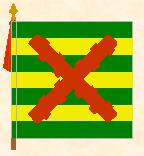
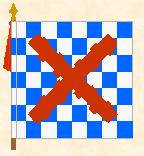
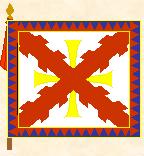
Tercio de la Liga 1571 ?
Tercio de Spinola 1621
(R&D Vol VIII n°19)

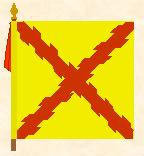
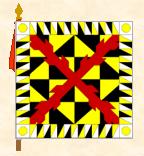
Flag company of the middle of the XVII century
Tercio Amarillos Viejos 1680
All the Spanish flags had the red Burgundy Cross which was the symbol of the Imperial Spanish forces. The background was choosen by the captain. Normal company flag was a square with size of 1.7 x 1.7 m, but some others flags (like the flag of the Tercio) had a size of 2.5 x 2.5 m or 2;0 x 2.5. The flag of the Tercio was the flag of the company of the Maestro de Campo who was also captain of the first company.
At that time (from the XVI century to mid-XVII century) troops did not have uniform (at last from 1525 to 1660) and the way to distinguish the Spanish from the others was to wear the red cross on the cloth or red or yellow plume and ribbon. The dutch used the orange color and the french the white.
In fact it seems that at company level it was possible to find some uniformity. The reason was that most of the time the Captain has to provide the vestido to the new recruits. Following Quatrefage, the vestido provide by the king consist in, 2 white shirts, a colourful coat, colourful stockings, a trouser and shoes. Some Tercios, in the Army of Flanders, were known for the quality of their cloths, others for the colour of their cloths (the Tercio of the Sacristanes because they all had black cloth). Generally speaking Spanish soldier of the army of Flanders were badly cloths most of the time. With the wet weather and the hard condition of living and fighting in Flanders, cloths would become ragged very quickly. In Italy Spanish soldiers had better cloths.
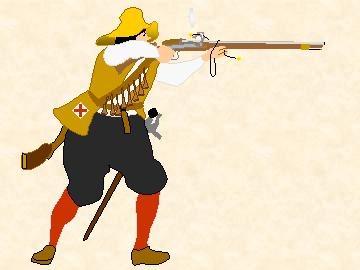
Harquebusier (begining of the XVII century) with a hat, prepared to fire his harquebus. He had a bandolier with ready-made doses of powder, a sword, a white shirt, a jacket o buff coat and a black trouser. He had also a flask for extra black powder and a small red cross of burgundy to define himself as a Spanish soldier.
Alférez from a pike company of a Spanish Tercio from the beginning of the XVII century. The officer had a half armour with tassets for the thighs, protection for the arms and the flg of his company. He wears red plumes and ribbons as well as a red scarf to define his nationality.
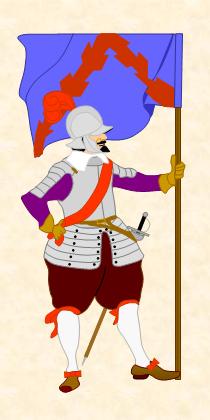
Officially the first tercios to have uniforms were the first five provincial Tercios in 1660 - 1670 decade. Some of the later provincial Tercios created in 1694 had also an official uniforms. The uniform was composed of a coat with a large label, a trouser, stockings, a white tie and a shirt normally white. The coat’s label and the label of the sleeve had the colour of the distinction. Normally, for the Spanish Tercios, the trouser was yellow and the stocking red (according to Conde de Clonard description). In a recent publication Boeri state, that trouser and stockings had the colour of the coat or of the distinction.
Concerning the Tercios of the Allied Nations and foreign mercenary we have few information, Boeri coments that the Italian used to be in blue purble, and the walloon in grey .
Has you can be seen, on the four figures and plates, a Spanish army of that time must be very colourful in comparison with the French army..
.
Soldiers of the second half of the XVII century


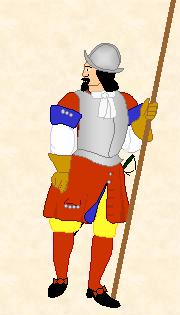

Musketeer from the Tercio of Sevilla (Morados Viejos):
the coat is purple, the distinction
is dark-red and the trouser yellowMusketeer from the Tercio of Toledo (Azules Viejos): the coat is blue, the distinction is white and the trouser yellow Pikeman from the Tercio of Armada Mar Oceano:
The coat is dark red, the distinction is blue and the trouser yellowGrenadier from a Tercio of the Army of Flanders Coat qnd trouser are light-grey, the distinction
red as well as the stockings
Presentation of some uniform's colour of the Tercios of the Spanish army for the 1682 – 1700 period
Note: it is difficult to give a precise description of the uniform, in the sources consulted we can find the coat and devise colour and sometime trousers and stockings. For some unit, I had to give my personal interpretation so please forgive some mistakes in the plates below, of course comments are most welcome.
Plate 1: Tercios and Regiments located in Spain or North Africa

Plate 2: Tercios and Regiments located in Flanders Plate 3: Tercios and Regiments located in Italy


Bibliography
Jesús Alia Plana,, El vestuario de los tercios, site web
J.L. Sanchez Martin, R&D n°21 p120
J.L. Sanchez Martin, R&D n°3
Bardot y Font, Francisco, Museo militar. Historia del ejército español, armas, uniformes, sistemas de combate, instituciones, organización del mismo... Barcelona 1886
Conde de Clonard, Historia orgánica de las armas de infantería y de caballería, Vol 4 and 5 edición de1855 - 1856, Madrid.
G.Boeri, J. L. de Mirecki Quintero and J. P. Cuñat, Los Tercios de Carlos II durante la Guerra de los Nueve años (1689-1697), La Espada y la Pluma, 2007
G. Boeri & G. Pierce R&D n°12
J. Montes Ramos, El Ejercito de Carlos II y Felipe V: el sitio de Ceuta 1694 - 1727, Agualarga Editores SL 1990
[Contents] [Chapter 1] [Chapter 2] [Chapter 4] [Chapter 5] [Chapter 6] [Chapter 7] [Chapter 8]